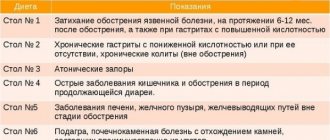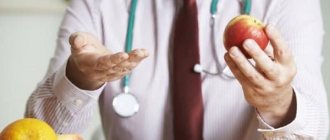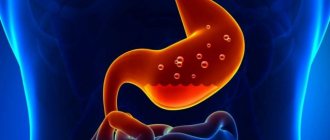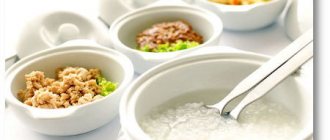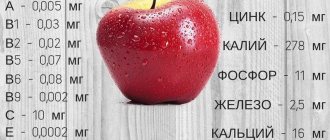Diet 5 table is a therapeutic diet that helps normalize the functioning of the gastrointestinal tract.
Prescribed for adults and children with problems with the liver, gall bladder and biliary tract. This diet contains all the necessary substances for humans and excludes foods harmful to the liver and pancreas. Gentle nutrition helps relieve stress from the entire gastrointestinal tract, as well as normalize the functioning of the liver and biliary system. For those who are obese, in addition to problems with the gastrointestinal tract, the 5th table diet will help you lose excess weight, as lipid (fat) metabolism in the body is normalized. If you adhere to this diet for a long time (up to 2 years), then patients experience stable remission, and the amount of medications necessary to maintain it decreases significantly.
For what diseases is it prescribed?
The diet is aimed at normalizing the functioning of the digestive organs, which are associated with the production and secretion of bile. This includes the liver, gallbladder and its ducts, and pancreas.
This therapeutic diet is indicated for the following diseases:
- chronic hepatitis;
- liver cirrhosis (in the absence of liver failure);
- chronic cholecystitis (inflammation of the gallbladder);
- gallstones;
- pancreatitis;
- gastroduodenitis;
- recovery period after removal of the gallbladder.
Sample menu
Since the diet is quite limited, it is quite difficult to imagine a varied menu. But this is achievable if you use standard recipes every day, but change their main ingredients. The same porridges and vegetable purees may not be repeated for 3-4 days. In addition, dairy products are allowed, from which you can prepare many delicious dishes for the 5p table.
- Breakfast: oatmeal with fruit puree, homemade yogurt.
- Lunch: semi-sweet lazy dumplings, tea with milk.
- Lunch: cauliflower soup, steamed cutlets, pasta, rosehip infusion.
- Afternoon snack: zucchini-carrot puree, compote, biscuits in small quantities.
- Dinner: cottage cheese casserole, kefir.
Table Features 5
- Fractional meals. It is necessary to eat small meals up to 6 times a day. This significantly reduces the load on the digestive system and helps you lose excess weight.
- Food temperature. Do not eat very hot or very cold food. The most beneficial temperature for food on a diet is moderately warm.
- Water. The amount of water that needs to be consumed per day is from 1.5 to 3 liters.
- Fried, salted, pickled, spicy. All these foods must be excluded from the diet, as they negatively affect the functioning of the liver and gallbladder.
- Squirrels. It is necessary to consume plant proteins and animal proteins in a total amount of 50% of the daily diet.
- Vegetables and fruits. Replenish the body's need for carbohydrates with the help of raw vegetables and fruits allowed on the diet (see table).
- Salt. At table 5, the amount of salt is reduced to 8-10 grams per day.
There is a type of diet table No. 5 - this is the diet table 5A, which is prescribed for acute hepatitis and cholecystitis. The effect of this diet is aimed at relieving the acute stage of the disease, after which, as a rule, the patient switches to dietary table 5 to maintain remission.
What is the difference between diet table No. 5 and table 5A? The main difference with the main diet table 5 is that all vegetables and fruits must be heat treated. In addition to excluding fried, spicy, fatty foods, all organic acids from vegetables and fruits are also excluded.
One of the features of the 5A diet is the prohibition of foods that cause fermentation in the intestines. This is another reason why vegetables and fruits are served boiled or baked.
The fifth table is gentle on the liver. What is possible? What's not allowed?
Chronic hepatitis, gallstones, chronic cholecystitis and pancreatitis, cirrhosis in the compensation stage, biliary dyskinesia are indications for this diet.
Diet Goal #5:
- restore the function of the gastrointestinal tract;
- normalize fat metabolism;
- improve cholesterol levels and bile flow.
A diet containing nutrients in the right quantities is designed to be long-lasting. It places the most stringent requirements on fats. The ban is imposed on products containing substances that are processed by the liver and increase the load on it:
- nitrogen is found in abundance in protein foods (including legumes, nuts, oils), as well as in early vegetables, watermelons with nitrates, sausages and smoked meats, which give their red color to nitrites;
- cholesterol from fatty meat (pork and offal, liver), fish (mackerel, stellate sturgeon and other varieties), eggs, fatty sour cream, cream;
- purines are metabolized into uric acid and are found in chocolate, cocoa, herring, anchovies, pork, peas, beans;
- oxalic acid is an oxalate that enhances gastrointestinal motility and is used in inorganic form in mustard, fatty meats, vinegar, chocolate and candies, cookies, cakes and ice cream;
- essential oils in onion, garlic and celery, parsley and dill, radish and radish can cause spasm of the smooth muscles of the liver;
- fiber , which stimulates the activity of the stomach and the muscles of the digestive organs.
List of products from the fifth table:
- Allowed vegetables include red cabbage, since it has 4 times less fiber than white cabbage and more carotene, cucumbers and tomatoes (not early), starchy (soft) vegetables: beets, carrots, potatoes, onions and peppers. The coarser the product, the finer it needs to be cut and ground.
- Oatmeal, buckwheat, semolina and rice cereals undergo strong heat treatment, so they are easily boiled and are suitable for nutrition. Porridges are necessary for dietary nutrition table 5.
- Ripe fruits contain more pectins and soft fibers: bananas, strawberries and other berries, apples need to be ground, pomegranate should be eaten without seeds, dried fruits should be soaked.
- Soups will fill the lunch time - only in light broths, without frying onions and carrots. Season with low-fat sour cream, chop the meat finely.
- Stew, boil and bake lean beef and chicken, rabbit. In the oven cook hake, pike perch, boil shrimp and stuff squid.
- From eggs, use mainly whites, but one yolk per day is allowed. Omelettes, casseroles, poached or pouched, as well as for stuffing and salads.
- Low-fat dairy products are a good dinner for the liver. Light cheese is allowed, which can be made at home from milk or kefir.
- Choose bread with less coarse fiber: wheat, second-grade rye, baked goods without yeast.
- Because of purines, brew teas weakly, drink juices diluted with water, homemade berry fruit drinks and compotes, decoctions of herbs and dried berries.
- Use butter and vegetable oils sparingly in porridges and salads.
- Eat sweets limited (once a day): marshmallows, marmalade, honey.
Diet 5 table, what is possible and what is not (table)
Below in the table you can see what you can eat and what you cannot eat on a gentle diet of diet 5. Use this information when creating a menu for the week.
| Products | What can you eat | What not to eat |
| Flour | Dried yesterday's bread. Galette baked goods | Fresh bread. Delicious and fresh baked goods. Puff pastry. Pancakes, pancakes, pies |
| Meat and poultry | Lean types of meat (veal, beef, rabbit, turkey fillet, chicken). Can be eaten boiled or baked | Fatty meats. Sausages. Roasted meat and poultry. Salo |
| Fish | Low-fat fish (pike perch, cod, perch) boiled or as a soufflé | Canned food. Fatty fish, smoked, salted fish |
| Cereals | Porridges made from buckwheat, oatmeal, semolina and rice cooked in water. The porridge is viscous, boiled. Puddings and casseroles made from these cereals are acceptable. Table 5 rules allow pasta made from durum wheat | Legumes, pearl barley, millet, corn grits |
| Soups | Slimy soups from permitted cereals, cooked in vegetable broth, or pureed soups | Borscht, okroshka, beetroot soup. Meat broth soups |
| Eggs | Protein omelet (1-2 pieces per day). Half a yolk per day is allowed | You should not eat hard-boiled or fried eggs. |
| Dairy | Low-fat milk, cottage cheese, yogurt, cheese | Fat cottage cheese, sour cottage cheese, fatty and spicy cheeses, ice cream, cream |
| Vegetables | Cucumbers, tomatoes, carrots, cabbage, and greens can be eaten raw. Beets, carrots, zucchini, cauliflower, potatoes, onions are consumed boiled | Salted, pickled vegetables. Raw onion. Garlic, radish, sorrel, mushrooms, spinach |
| Fruits | Apples, pears, bananas, melons, peaches, watermelon. Non-acidic berries: raspberries, strawberries, blueberries. Dried fruits: prunes, dried apricots, dates, raisins | Nuts. Sour fruits and berries |
| Sweets | Honey, pastille, jam, marmalade, marshmallows | Chocolate. Ice cream. Confectionery products containing margarine and butter |
| Beverages | Weak green tea, rose hip decoction, fruit juices diluted half and half with water. Non-acidic dried fruit compotes | Alcohol, coffee, cocoa. Strong black or green tea. When following a diet, do not drink drinks with ice. |
Nutrition during exacerbations
In the acute period of liver and gallbladder diseases, diet 5a is practiced - a table with a limitation of fats and mechanical irritants of the gastrointestinal tract:
- What is possible? Products allowed for table No. 5, but only boiled until soft and ground, which especially applies to meat and vegetables.
- What's not allowed? In addition to the prohibitions listed in the general fifth table, vegetables are added in the form of salads, hard-boiled and soft-boiled eggs, fresh bread and other pastries, and crumbly cereals.
- How to cook? Purees, soufflés, omelettes, steaming, pureeing.
- What drink? Kissels from non-acidic fruits, rosehip decoction, weak tea.
A sample menu for the day looks like this:
- Soufflé made from steamed pureed cottage cheese, grated rice.
- Baked apple.
- Soup with oatmeal, zucchini and carrots, steamed chicken cutlets.
- Rose hip decoction.
- Mashed potatoes, steamed fish dumplings, semolina casserole with powdered sugar.
- Low-fat kefir.
How to create a sample menu
To create an approximate menu for a week for diet table No. 5, you must adhere to several rules:
- at least 5-6 meals, between them you can add snacks in the form of fruit (apples, bananas, dried fruits, biscuits);
- Try to make every meal satisfying, but the amount of food should be small, because the main rule on the diet is split meals;
- Every day it is necessary to include fresh vegetables and fruits in the menu;
- several times a day you need to eat protein foods: low-fat cottage cheese, fish, meat;
- combine fish and meat with fresh vegetables;
- in addition to compotes and tea, drink a lot of water;
- in order for the table 5 diet menu dishes to be varied, but not take a lot of time, use freezing (freeze, for example, applesauce from baked apples, semi-finished lazy dumplings, cottage cheese casserole, soups, etc.), this will significantly save time and the diet will not be repeated for 2-3 days.
What you can and cannot eat, cooking tips
This is the most universal diet that is suitable for diseases of the gastrointestinal tract at the subside stage. It is balanced, contains all the vitamins and microelements necessary for the body.
It is necessary to choose products that contain a lot of fiber and pectin (all types of fruits, except plums, cranberries, citrus fruits). You need to eat small portions up to six times a day.
When preparing food, food must be boiled, steamed, baked, sometimes stewed, but without adding oil.
Products containing cholesterol, purines, and essential oils are prohibited. The total calorie content per day is 2400-2600 kcal (proteins - 90 g, carbohydrates - 400 g, fats - 80 g).
List of allowed foods on the fifth table diet:
- Dried bread or crackers.
- Soups with vegetables and the addition of cereals (buckwheat, rice, barley) or noodles. Vegetables are not allowed to sauté.
- Meat and fish of low-fat varieties.
- Milk, low-fat cottage cheese.
- Steam omelettes.
- Boiled or stewed vegetables (pumpkin, eggplant, zucchini, cabbage, carrots). Raw vegetables allowed are cucumbers, tomatoes, and lettuce.
- Bananas, apples, dried fruits.
- Kissel, tea, juice, rosehip decoction.
- Marmalade, marshmallows, sugar, honey.
Prohibited products:
- Fried, spicy foods, smoked meats, canned food, sausage.
- Products that increase intestinal bloating (millet, legumes, white cabbage).
- Marinated, salted mushrooms and vegetables.
- Strong meat soups.
- Sour fruits and berries (plums, cranberries, oranges, tangerines).
- Cream, full-fat cottage cheese, sour cream.
- Cream cakes, ice cream, chocolate.
- Coffee, cocoa, carbonated drinks.
Diet menu table number 5 for the week
| Day of the week | Breakfast | Lunch | Dinner | Afternoon snack | Dinner |
| Monday | Oatmeal in water with mashed banana and sweet berries (previously defrosted to room temperature, or fresh), green tea with honey | Steamed omelette, marmalade | Cauliflower and carrot soup, chicken pudding, cucumber and tomato salad, dried fruit compote, sweet crackers | Cottage cheese with low-fat sour cream and sugar | Stewed pike perch, vegetables, compote |
| Tuesday | Cottage cheese casserole with sour cream sauce (remember that diet 5 uses low-fat sour cream) | Fruits (banana, apples) | Vegetable soup with meatballs, pilaf, tomatoes, green tea | Baked apples with honey | Baked fish fillet, Chinese cabbage salad with low-fat sour cream |
| Wednesday | Steamed lazy dumplings with fruits and berries, fruit juice | Meat puree, fresh vegetable salad, biscuits, green tea | Fish soup, steamed rabbit cutlets, buckwheat porridge, vegetables stewed in water, fruit juice | Banana casserole with cottage cheese and sour cream, compote | Steamed omelette, kefir |
| Thursday | Cauliflower casserole with sour cream sauce, fruit | Baked apples with cottage cheese and banana | Broccoli soup, turkey and potato stew, fresh vegetable salad, marshmallows, juice (according to the diet, it is better to refrain from dessert if you feel full) | Zucchini stew, biscuits, tea | Cottage cheese with raspberry jam, kefir |
| Friday | Oatmeal with fruits and sweet berries, green tea | Stuffed zucchini, greens, compote | Buckwheat soup, navy pasta, fresh vegetable salad, fruit juice, marshmallows | Applesauce, biscuits | Lazy dumplings with honey, kefir |
| Saturday | Cottage cheese, banana and apple puree, green tea | Cauliflower and zucchini stew | Chicken noodle soup, turkey meatballs, fresh vegetable salad, marmalade, compote | Baked fish, Chinese cabbage salad | Galette cookies, low-fat yoghurt with fruit puree |
| Sunday | Lazy dumplings with honey, kefir | Vegetable puree soup, fruit juice | Rice soup, cabbage rolls, mashed potatoes, fresh vegetable salad, green tea | Stewed fish with tomatoes, compote | Cottage cheese with raspberry jam, compote |
Here is an example of how you can create a completely varied diet from the same products on the Table 5 diet. But the essence of this diet is not in variety, but in medicinal properties. The main task is not the number of new dishes every day, but their quality from a medical point of view.
Main prohibited foods
To maintain health, exclude from the diet:
- white cabbage, radish, radishes, green onions, sorrel, garlic, spinach, parsley, fresh vegetables rich in fiber, essential oils, and pickled ones - in vinegar;
- legumes and mushrooms for protein and nitrogen,
- pearl barley, wheat, barley and corn, filled with coarse fibers;
- grapes, plums, sour apricots, cherries - sour and flatulence-promoting fruit varieties;
- rich broths with fish, chicken with skin, pork, beef, mushrooms;
- fatty meat and fish, homemade dairy products;
- pastries, puff pastries, fresh bread, pizza;
- seasonings, horseradish, mustard, mayonnaise, pepper;
- chocolate, cocoa, halva, sweets;
- strong tea, coffee, carbonated drinks and concentrated juices, milkshakes, as they are cold and contain ice cream with trans fats.
Based on what is and is not possible, we will draw up an approximate diet menu 5.
Breakfasts:
- oatmeal soup without broth, low-fat cottage cheese with berries;
- pilaf with steamed dried fruits, yogurt without fat and sugar;
- rice and cottage cheese pudding with apple jam, banana;
- viscous buckwheat porridge, egg and white omelette, apple and carrot puree;
- cheesecakes with dried apricots, a glass of kefir and wheat bread with jam;
- casserole of rice, cottage cheese and dried fruits, cocktail with milk and banana;
- egg white omelette with green beans and tomatoes, fat-free yogurt.
Lunches:
- borscht without broth, steamed lean beef cutlets, stewed zucchini with carrots;
- bulgur salad with tomatoes and herbs, baked chicken fillet with sour cream;
- zucchini and carrot soup, cod baked in foil;
- turkey meatballs with rice, boiled cauliflower soup with zucchini;
- buckwheat soup, lean boiled beef, shredded cabbage salad with cucumber;
- casserole of minced chicken, zucchini, green beans and peppers with rice, stewed tomatoes;
- beetroot soup (or cabbage soup according to the season) with boiled veal, salad of peas, zucchini and carrots without oil.
Dinners:
- vinaigrette, egg (if there was none in the morning and afternoon), cottage cheese with dried fruits;
- lazy cabbage rolls with yoghurt sauce, boiled beet salad with raisins;
- salad of boiled rice, cucumber, tomato and red cabbage with low-fat yogurt, stewed fish (cod or pollock);
- beef stew with eggplant and peppers, pasta and some feta cheese;
- stewed chicken fillet with vegetables, bread with low-fat cottage cheese;
- salad of grainy low-fat cottage cheese, boiled carrots, prunes and sour cream, boiled broccoli;
- minced chicken meatballs or dumplings, green beans, kefir with dried apricots.
Snacks:
- baked pear (apple) with honey;
- sliced banana, apple and raisins with low-fat yogurt;
- pita bread with boiled chicken, tomato and herbs;
- cottage cheese cookies with raisins and banana;
- bread with squash caviar, two pieces of homemade chicken sausage with sweet pepper;
- manna with dried apricots;
- carrot pancakes from semolina in the oven.
It is better to eat marshmallows, marmalade, Turkish delight, non-sour jam and other sweets half an hour after the main meal, since snacking on foods with sugar can provoke a craving for them and a violation of the dietary regime.
You will have to adhere to the diet prescribed by your doctor for two years or more, and expand it only under the supervision of a specialist . Dishes and products of the diet can be supplemented or reduced depending on the individual course of the disease.
Basic rules of the 5p diet
Any diet is based on two things: permitted foods and nutritional rules. One doesn't work without the other. With this diet, you should lean on protein foods, which reduce the amount of gastric juice. It is worth limiting the intake of fats to a minimum (up to 80 g per day), excluding refractory types.
Other rules of the therapeutic diet:
- Drink 1.6 liters (8 glasses) of free water daily, excluding other liquids. Carbonated mineral water is prohibited.
- The serving size on the diet should not exceed 300 g.
- Every day you should have at least five, ideally six, meals. The maximum break is 4 hours, it is better to take windows of 2.5-3 hours.
- It is mandatory to reduce the amount of salt on the diet to 8-10 g. It is important to remember that it is also present in some ready-made products.
- During the diet, it is important to take neither cold nor hot food or liquids. Food should have a body temperature of plus/minus 5 degrees.
- The therapeutic diet involves the complete exclusion of alcoholic beverages. Smoking also provokes attacks, reducing all efforts to zero.
For Diet 5 to really help with pancreatitis, you need to follow all this. In rare cases, the doctor prescribes temporary fasting, but according to indications (cirrhosis, hepatitis).
Important! When following a therapeutic diet, it is recommended to take vitamin complexes with choline and other B vitamins.

